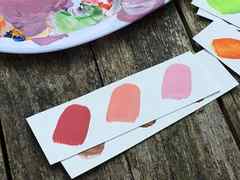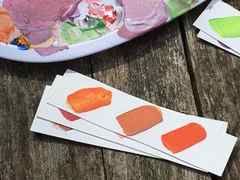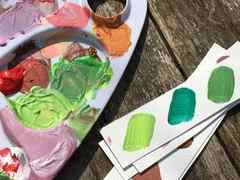More paint-related know-how on our hub page. And find all our DIY projects in one place, too.
How To Make The Color Purple: 60+ Amazing Acrylic Paint Recipes!
Meet Sara, a 30-year acrylic painting veteran. Specializing in paint mixing to create stunning new colors, she’s not only undertaken numerous commissions but also independently sold her captivating art. With over a decade of art gallery management, Sara’s profound understanding of the art world shines. Dedicated to helping her new painting pals find success along their artistic journey, she is committed to staying up-to-date with techniques and trends, making her a valuable resource for beginners to acrylic painting.
Latest posts by Sara (see all)
- 12 Fiendishly Fun Halloween Painting Ideas For Beginners – October 6, 2023
- 125+ Easy Painting Ideas For Beginners – August 30, 2023
- How To Use Acrylic Paint: Acrylic Fun 101! – August 10, 2023
Some of the links in this article are affiliate links which means that if you choose to click on them and make a purchase, I earn a small commission at no extra cost to you.
Also, as an Amazon Associate, I earn from qualifying Amazon purchases.
For more details, please read the full disclosure here.
Thanks so much for your support!
Let’s have fun with another color experiment. This time, we’re going to look at how to make the color purple.
You’re probably thinking, don’t you just mix blue and red? And, generally speaking, you’d be right. That said, there’s quite a bit more to making a purple paint color than most people expect.
Let’s dive into some experimenting with different blues and reds and maybe we’ll throw in a few other colors.
You’ll be able to follow this process step by step through photos and detailed explanations. I’ll also include all of the recipes that I use so you can take the ones you want and add them to your own color-mixing recipe book. Let’s get started!
In This Article.
- Paint Colors You Can Use To Make Purple
- What Two Acrylic Paint Colors Make Purple?
- How To Mute The Color Purple So It’s Less Vibrant
- How To Make The Color Purple Lighter
- How To Mix The Perfect Lavender Acrylic Paint Color
- Can You Make Purple Acrylic Paint Even Darker?
- Mixing Up A Royal Purple Color
- How To Make An Icy Cool Purple Color
- Making A Warm Color Purple
- How To Make The Color Purple Using…Brown.
- Even More Acrylic Paint Recipes For Making The Color Purple!
- How To Use Purple In Your Artwork
- Final Thoughts On Experimenting With Making Purple Paint
Paint Colors You Can Use To Make Purple
Below, you’ll find a list of all paint colors used for each purple color experiment and any other mixture mentioned. Don’t worry, I go into detail with recipes and paints used for all of the experiments. I also throw in a few bonus paint mixes that will give you purple so you’ll definitely want to stick around for that!
In addition, I’ve dropped a ton of links where you can check prices and availability, in case you see something you just can’t live without. That said, some of the Arteza paint colors listed came in a set of 60 so I didn’t want to link it to each individual paint color. If you do see a color that you want, I highly recommend the Arteza Premium Set of 60. It’s got metallics and even a neon pink that’ll make you go “wowza”.
So, if you’ve been researching how to make the color purple, look no further, my friend!
Master List of Paint Colors Used In Experiments:
- Cadmium Red Medium (Liquitex Basics)
- Alizarin Crimson (Liquitex Professional Heavy Body)
- Cadmium Red Deep (Liquitex Basics)
- Rose Madder (Arteza Premium)
- Quinacridone Magenta (Liquitex Basics)
- Magenta Light (Arteza Premium)
- Rose Azo (Pebeo)
- Cadmium Orange (Liquitex Basics)
- Yellow Oxide (Liquitex Basics)
- Cadmium Yellow Medium (Liquitex Basics)
- Naples Yellow (Arteza Premium)
- Phthalo Green (Liquitex Basics)
- Light Green Permanent (Liquitex Basics)
- Hooker’s Green (Liquitex Basics)
- Light Sap Green (Arteza Premium)
- Chromium Oxide Green (Arteza Premium)
- Cerulean Blue (Liquitex Basics)
- Ultramarine Blue (Liquitex Basics)
- Phthalo Blue (Liquitex Basics)
- Primary Blue (Liquitex Basics)
- Cobalt Blue (Liquitex Basics)
- Diox Purple (Liquitex Basics)
- Violet (Arteza Premium)
- Titanium White (Liquitex Basics)
- Zinc White (Golden Professional Heavy Body)
- Unbleached Titanium (Liquitex Basics)
- Burnt Umber (Liquitex Basics)
- Raw Umber (Liquitex Basics)
- Burnt Sienna (Golden Professional Heavy Body)
- Mars Black (Liquitex Basics)
Experiment Disclosure: Please keep in mind that lighting, screen settings, and even using different brands of acrylic paint can alter the color seen so your results may vary from mine.
Also, a “part” can be any amount of paint. The most important thing is to make sure all “parts” are roughly the same amount/size.
What Two Acrylic Paint Colors Make Purple?
First of all, to make a purple color in its truest form, you’d need to mix primary blue and primary red in equal parts.
But that isn’t the only red and blue you can use. You can take any red and blue, mix them together in different ratios, and end up with a different purple every time.
This is where experimenting with your paint is so good! Just because you have red and blue, or maybe a couple of reds and a couple of blues, doesn’t mean that’s all the paint color you have. With those different blues and reds, you can make a gazillion purples and get your money’s worth out of your paint.
Of course, you’ll have to do some experimenting of your own to see exactly what kind of purples you can make with what you already have in your collection.
But, just in case you have some of the same paint colors that I have, I’m going to share every single color mixing recipe to get you started.
Paint Colors Used:
- Ultramarine Blue (Liquitex Basics)
- Phthalo Blue (Liquitex Basics)
- Cerulean Blue (Liquitex Basics)
- Cadmium Red Medium (Liquitex Basics)
- Alizarin Crimson (Liquitex Professional Heavy Body)

- One part Cad Red Medium to one part Ultramarine Blue
- Three parts Cad Red Medium to one part Phthalo Blue
- One part Cad Red Medium to one part Cerulean Blue
- One part Alizarin Crimson to one part Ultramarine Blue
- Two parts Alizarin Crimson to one part Phthalo Blue
- One part Alizarin Crimson to one part Cerulean Blue
In the photo above, you can see that there isn’t a lot of difference between using Cadmium Red Medium or Alizarin Crimson to make purple.
The one spot you’ll notice a bit of a change is when both reds are mixed with Phthalo Blue.
Phthalo Blue is a very strong pigment so I started by showing you what the mixture looked like as a one-to-one ratio and then start adding more parts of the two reds until a proper purple color was achieved.
In the Cadmium Red Medium experiment, I had to add three parts to one part Phthalo Blue.
On the other hand, I only had to add two parts Alizarin Crimson to one part Phthalo Blue. This tells us that Alizarin Crimson has more pigment load than Cadmium Red Medium.
That said, we have to take into consideration that the Cad Red Medium used in this experiment was a student grade whereas the Alizarin Crimson was a professional grade.
So, what did we learn through these two experiments? First, Phthalo Blue needs to be added slowly because it will easily overtake other pigments, and second, Cad Red Medium and Alizarin Crimson, although very different hues, end up creating purple paint very close in color.
How do you make colour Purple?

This question has been asked a million times over! let us start by saying don’t panic, there are many shades of purple paint on the market already premixed, and at the end of this article we will list all the options available to buy from our website if you need a quick fix.
However, knowing how to make the perfect shade of purple paint which complements your palette is invaluable, especially if you already own a number of Blue and Red pigments. But contrary to common belief, not every Blue and Red pigment will work together to create a vibrant Purple colour! Nor would you want to make the same vibrant Purple every time. There are different shades of purple, for many different functions within a painting, bright purples for floral scenes in bright sunlight, muted purple and dark shades of purple for cast shadow or deep shadows and so on. Various shades of purple bring interesting conversations and transitions of colours to a painting and can make their complimentary colours sing!
In our last two blogs we talked about warm Red paint colours with a yellow/orange bias and cool Red paints with a Blue Bias and identified many of the common Red paint names on the market. In this article, we will expand on choosing the correct Blue pigments and why. Using the correct warm or cool Red and Blue paint will inevitably save you time and money.

How to determine a colour bias in your Blue and Red paints/pigments.
Firstly what does colour bias mean? When you buy paint, not all of them contain a single pure pigment, actually most paints are a mix of pigments, especially if it has the word ‘Hue’on the label. The word Hue describes a mix of alternative synthetic pigments which are used to create either, a historical colour which is no longer manufactured for reasons of toxicity or the ‘Hue pigment’ replaces a more expensive natural mineral ingredient pigment. For example traditionally made Ultramarine is made by crushing Lapis Lazuli, a semi precious stone which is very expensive, whilst French Ultramarine pigment was developed as a cheaper alternative.
This results in pigments having a colour bias and the way to find this out is by mixing the pigment with a small amount of white paint. If a Red paint has a blue bias it will naturally look cooler than a Red paint that has a yellow/orange bias. A Blue pigment with a greener appearance will have a warm Bias, again once mixed with a white pigment will allow you to distinguish the pigment’s characteristic. A cool Blue pigment would have a Red bias.
There are naturally two schools of thought to this ‘Temperature’ of a colour debate! And for those who are searching for answers on the World Wide Web it can get rather confusing, so because this subject is not black and white we suggest you use your own subjective judgment and your own perception of the colours, as no two people will see colour the same. The thing to remember is that there are no absolutes in colour; everything is relative to what it is next to on the canvas, so we have to see colour in context when making colour choices in painting.
Colours that are muted and cooler usually recede in a painting, creating atmospheric perspective, or distant horizons, mountains, trees etc. Whilst colours that are bright and warm are usually painted in the foreground and advance. Our lists below are suggestions of warm and cool colours to be tested!

Warm Reds;
with a Yellow/Orange bias; (Different Brands may provide a slightly different shades)
- Cadmium Red, Cadmium Red light, Cadmium Red deep, Indian Red, Orange Red, Primary Red, Perylene Red, Pyrrole Red, Red Oxide, Spectrum Red, Winsor Red, Vermillion, Venetian Red, Vivid Red Orange, PR 9 – Naphthol Red.
How to make pink paint
Pink is just one of those colours that pops and you hardly have to use any of your primary colours to achieve it. A drop of red in a pool of white will still give you a candy floss pink.

How to make a bubblegum pink paint:
1. Mix four parts white with one part red.
2. Add more red to get a deeper colour. Add more white to make it lighter.
How to make a salmon pink paint:
1. Mix three parts white with one part red.
2. Add one part yellow and mix.
3. Add a little white to tone it down to more of a cooked salmon.
How to make fuchsia pink paint:
1. Mix together three parts red with one part white
2. Add a drop of blue
How to make orange paint
Orange is the colour of sunshine and all things summery. While we’re stuck indoors, adding a splash of orange and yellow to your paintings, art projects and even interiors can be a way to brighten up your day. The secret ingredient to warm orange paints is sticking to combinations of red and yellow.

1. Mix equal parts red and yellow.
2. Add more red for a bolder orange.
How to make green paint
Green is the colour of nature and health. When your kids are painting landscapes, green paint will often be the basis of their palette. For turquoise oceans just add more blue, for fields of green, think more parts yellow.

1. Mix together equal parts yellow and blue.
2. Add more blue for turquoise and more yellow for a chartreuse.





